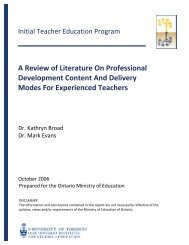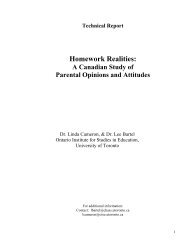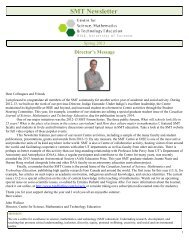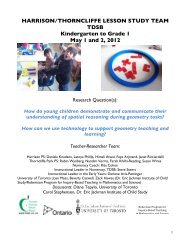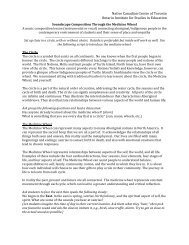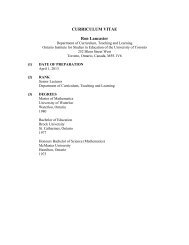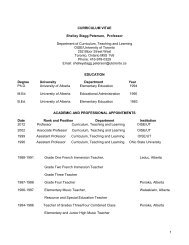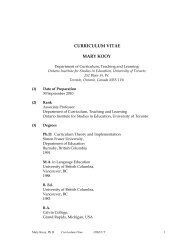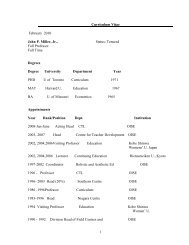The Ontario Curriculum, Grades 9-12 - Ministère de l'éducation ...
The Ontario Curriculum, Grades 9-12 - Ministère de l'éducation ...
The Ontario Curriculum, Grades 9-12 - Ministère de l'éducation ...
Create successful ePaper yourself
Turn your PDF publications into a flip-book with our unique Google optimized e-Paper software.
INTERDISCIPLINARY STUDIES, GRADES 11 AND <strong>12</strong><br />
(2002)<br />
See the Preface for important information on the organization of the following material.<br />
<strong>The</strong> <strong>de</strong>pth of knowledge relating to the environment that stu<strong>de</strong>nts may acquire in single-credit<br />
interdisciplinary studies courses or multiple-credit packages will <strong>de</strong>pend on the courses selected for<br />
interdisciplinary study. <strong>The</strong> <strong>The</strong>ory and Foundation strand in each interdisciplinary studies course<br />
emphasizes examining each discipline from the perspective of the other component discipline(s),<br />
and focuses on the use of higher-level thinking skills to integrate knowledge and skills associated<br />
with the different disciplines. This approach supports systems thinking, a form of analysis that is<br />
essential for un<strong>de</strong>rstanding environmental issues and concerns. <strong>The</strong> other two strands in the<br />
interdisciplinary studies courses – Processes and Methods of Research, and Implementation,<br />
Evaluation, Impacts, and Consequences – will equip stu<strong>de</strong>nt with other important inquiry and<br />
critical-thinking skills that will help them become environmentally literate citizens.<br />
Interdisciplinary Studies, Gra<strong>de</strong> 11, Open (IDC3O/IDP3O)<br />
Implementation, Evaluation, Impacts, and Consequences<br />
• analyse and <strong>de</strong>scribe the impact on society of interdisciplinary approaches and solutions to<br />
real-life situations<br />
– <strong>de</strong>scribe and critically analyse contemporary examples of interdisciplinary products and<br />
activities that provi<strong>de</strong> innovative approaches and solutions to a variety of real-life<br />
situations in the local community (e.g., the coordination of local transportation systems,<br />
the <strong>de</strong>livery of services through e-commerce and e-government, the <strong>de</strong>velopment of<br />
community health and recreation facilities)<br />
Note: Stu<strong>de</strong>nts can choose an environmental issue or project as one of the real-life situations that<br />
would be the object of their study of interdisciplinary approaches.<br />
Interdisciplinary Studies, Gra<strong>de</strong> <strong>12</strong>, University Preparation<br />
(IDC4U/IDP4U)<br />
Implementation, Evaluation, Impacts, and Consequences<br />
• analyse and <strong>de</strong>scribe the impact on society of interdisciplinary approaches and solutions to<br />
real-life situations<br />
– <strong>de</strong>scribe and critically analyse the contributions to society of leading practitioners who have<br />
engaged in interdisciplinary en<strong>de</strong>avours related to the subjects or disciplines studied and<br />
<strong>de</strong>scribe the potential impact of their work on future society (e.g., David Suzuki, biologist;<br />
Buckminster Fuller, futurist; Margaret Mead, anthropologist; Douglas Cardinal, architect)<br />
82 Environmental Education, <strong>Gra<strong>de</strong>s</strong> 9−<strong>12</strong>: Scope and Sequence of Expectations, 2011



